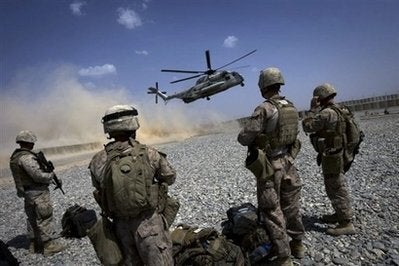
The New York Times reports that Ahmed Wali Karzai, the brother of the Afghan president and a suspected player in the country's booming illegal opium trade, gets regular payments from the Central Intelligence Agency, and has for much of the past eight years, according to current and former American officials.
Karzai's duties include helping to recruit an Afghan paramilitary force that operates at the CIA's direction (for now) in and around the southern city of Kandahar, and he is also the CIA's landlord. Karzai rents the former home of Mullah Mohammed Omar, the Taliban's founder, to the CIA and American Special Operations troops for paramilitary operations spearheaded by a group called the Kandahar Strike Force. On at least one occasion, the Times reports, the strike force has been accused of mounting an unauthorized operation against an official of the Afghan government.
This, to put it mildly, seems like a weird strategy considering Karzai is a player in the opium trade, a major source of revenue for the Taliban.
It appears as though the CIA is -- yet again -- employing the good ol' "The Enemy of My Enemy is The Guy Who Screws Me In The End" foreign policy doctrine utilized by the United States and its allies when they supported the Afghan Mujaheddin in their efforts to thwart the occupying Soviet power.
That worked out fine, right?
The Times muses that supporting a drug lord may undermine America's efforts of developing an effective central government that can "maintain law and order and eventually allow the United States to withdraw." I would agree. Propping up a major drug player and bankrolling his culture of corruption may not be the wisest strategy in a game entirely based on stabilization.
Of course, none of this is new to the Afghan strategy. At the start of the war, American officials paid warlords with -- what the Times adorably describes as -- "questionable backgrounds" to help topple the Taliban and maintain order with relatively few American troops committed to fight in the country. Even those warlords that didn't directly benefit monetarily from the United States were nonetheless permitted to flourish in the chaotic aftermath of the U.S. led invasion.
There was Mohammed Qasim Fahim. After the U.S.-led invasion of Afghanistan in 2001, Fahim became first defense minister and then vice president of Afghanistan. But before all that, he was the former senior commander of the Jamiat-e-Islami militia, and was named by Human Rights Watch in its 2005 report Blood Stained Hands as a key commander in the Afshar Massacre during which about 800 members of the Shia Muslim Hazara minority were killed in a bout of murder, rape and looting in a civilian area of Kabul in September 1992.
Then there was Haji Mohammed Mohaqiq, leader of the notorious Hezb-e Wahdat, which in late 2001-early 2002 targeted Pashtun civilians for violence because of their ethnic ties to the Taliban. Human Rights Watch reports that Hezb-e Wahdat
"[was] implicated in systematic and widespread looting and violence in almost every province under their...control, almost all of it directed at Pashtun villagers. In scores of villages, homes were destroyed, possessions were taken, and men and boys were beaten and in some cases killed....
[T]here were several reports of rapes of girls and women. In Chimtal district near Mazar-e Sharif, and in Balkh province generally, both Hizb-i Wahdat and Jamiat forces were particularly violent: in one village, Bargah-e Afghani, Hizb-i Wahdat troops killed thirty-seven civilians."
Mohaqiq moved on to become vice chair of the interim government and Minister of Planning where he used threats and intimidation against other delegates. You can take the boy out of the human rights violations, but you can't take the human rights violations out of the boy, am I right?
In order to intimidate delegates, Mohaqiq formed a militia that became famous for kidnapping young girls, "forcibly marrying" them AKA raping them, and ransoming them back to their parents. Their favorite strategy was to snatch up girls who were on their way to school, which resulted in parents keeping their girls home rather than risk their abduction and rape.
Good news: President Karzai has promised to carve out a province for Mohaqiq so he can roam free, happily raping and pillaging.
Then there's Gulbuddin Hekmatyar and Jalaluddin Haqqani, two warlords who were once among America's most valued allies. In the 1980s, the CIA funneled hundreds of millions of dollars in weapons and ammunition to help them battle the Soviets. Now, Hekmatyar is "as vicious as they come," according to a senior defense official, while Haqqani's son (Haqqani himself is believed to be dead) "is definitely the strongest" enemy in the border provinces of Paktia, Paktika, and Khost, known among military officials as p2k.
The list goes on, and on, and on. The names change, but the results are always the same: the enemy of my enemy is the guy who screws me in the end. It's almost like funneling hundreds of millions of dollars into a culture of unaccountability, rape, torture, kidnapping, drugs, and corruption is a really bad idea. Oh well. That's why I'm not paid as a "serious expert." I'm sure Henry Kissinger is somewhere, saying something really valuable about this subject. Let's ask him.
Cross-posted from Allison Kilkenny's blog. Also available on Facebook and Twitter.